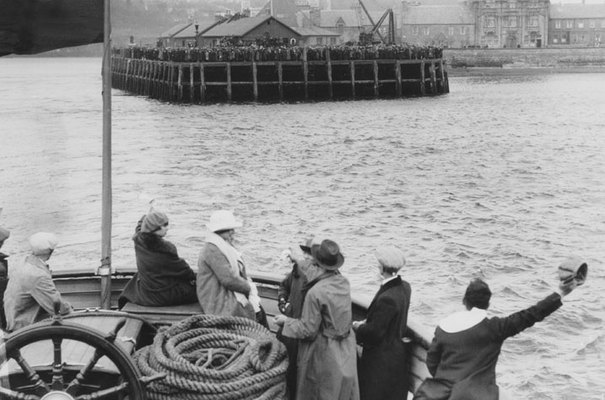
Emigration
At different times throughout history Scots have emigrated to different parts of the world, and some still emigrate to this day looking for better opportunities elsewhere. It is common for Scottish families to have relatives in Australia, Canada, New Zealand, the USA, or in England or Ireland.
The times when most Scots have left their homeland have coincided with times of severe economic depression, such as the 19th century and the beginning of the 20th century.
However, the bulk of Scottish emigration has been to North America and to Australia and New Zealand. In the 18th and 19th centuries many Gaels from the Highlands and Islands were forcibly evicted from their land to make way for more profitable sheep farming. Sometimes the families had to leave because they were poor; the landlords kept putting their rents up, and when they could not pay the landlords would take away their possessions, or put them out of their houses. So they decided instead to make the dangerous journey across the Atlantic in search of a better life. The journey was long and the ships often overcrowded, and many died on the way.
The money earned working seaweed for the kelp industry had reduced greatly, and when the potato crop failed in the 1830s and again in the 1840s many people faced starvation. Some landlords forced their tenants to leave, during an infamous period that became known as the Highland Clearances.
Emigration became easier for the poorest people in 1851, with the Emigration Act of that year. There was even a society, the Highlands and Islands Emigration Society, set up to manage the programme of resettlement. This was a period of mass exodus from the western islands of Scotland in particular, such as Skye, Mull, Lewis and Uist. There was a huge decline in the number of Gaelic speakers in Scotland, as so many of them were forced to e migrate.
Most of these families went to North America. Many of the earliest waves of emigrants went to Carolina and later to Ontario or Nova Scotia (New Scotland) in Canada. The highlanders were joined by many unemployed labourers and small farmers from the lowlands of Scotland, also driven out by poverty and seeking land and opportunity for themselves and their families. After 1830 many Scots also emigrated to Australia and New Zealand. It is estimated that a quarter of a million Scots went to these countries between 1830 and 1900. By 1850, Scots made up a quarter of the population of New Zealand.
About 300,000 Scots left in the 1920s. Many went from the islands, with emigrant ships such as the SS Marloch and the SS Metagama taking about 600 passengers in 1923 from Lochboisdale in Uist and Stornoway in Lewis to Alberta and Quebec.
In the period between 1831 to 1931, it is estimated that almost three million Scots left the country to settle elsewhere. Many of these did very well in their new homelands – Alexander Mackenzie from Stornoway was a famous explorer and the Mackenzie River in Canada is named after him. John Muir from Dunbar was the founder of the National Parks in the USA. In the present day, USA president, Donald Trump, is the son of an emigrant from Lewis.
Timeline

Games
Who can find the most Scottish place-names in Canada/in the USA/in Australia/in New Zealand?
Activities
- Find out if you have relatives who emigrated. Why did they go and where did they go?
- Research Scots who became famous after they emigrated.








 This project has been funded with support from the European Commission.
This project has been funded with support from the European Commission.